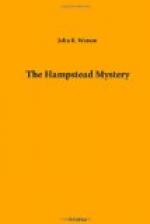On the morning after the discovery of the murdered man’s body, the two officers made their way to Tanton Gardens from the Hampstead tube station. Inspector Chippenfield was a stout man of middle age, with a red face the colour of which seemed to be accentuated by the daily operation of removing every vestige of hair from it. He had prominent grey eyes with which he was accustomed to stare fiercely when he desired to impress a suspected person with what some of the newspapers had referred to as “his penetrating glance.” His companion, Rolfe, was a tall well-built man in the early thirties. Like most men in a subordinate position, Rolfe had not a high opinion of the abilities of his immediate superiors. He was sure that he could fill the place of any one of them better than it was filled by its occupant. He believed that it was the policy of superiors to keep junior men back, to stand in their light, and to take all the credit for their work. He was confident that he was destined to make a name for himself in the detective world if only he were given the chance.
When Inspector Chippenfield had visited Riversbrook the previous afternoon, Rolfe had not been selected as his assistant. A careful inspection of the house and especially of the room in which the tragedy had been committed had been made by the inspector. He had then turned his attention to the garden and the grounds surrounding the house.
Whatever he had discovered and what theories he had formed were not disclosed to anyone, not even his assistant. He believed that the proper way to train a subordinate was to let him collect his own information and then test it for him. This method enabled him to profit by his subordinate’s efforts and to display a superior knowledge when the other propounded a theory by which Inspector Chippenfield had also been misled.
When they arrived at the house in which the crime had been committed, they found a small crowd of people ranging from feeble old women to babies in arms, and including a large proportion of boys and girls of school age, collected outside the gates, staring intently through the bars towards the house, which was almost hidden by trees. The morbid crowd made way for the two officers and speculated on their mission. The general impression was that they were the representatives of a fashionable firm of undertakers and had come to measure the victim for his coffin. Inside the grounds the Scotland Yard officers encountered a police-constable who was on guard for the purpose of preventing inquisitive strangers penetrating to the house.
“Well, Flack,” said Inspector Chippenfield in a tone in which geniality was slightly blended with official superiority. “How are you to-day?”
“I’m very well indeed, sir,” replied the police-constable. He knew that the state of his health was not a matter of deep concern to the inspector, but such is the vanity of human nature that he was pleased at the inquiry. The fact that there was a murdered man in the house gave mournful emphasis to the transience of human life, and made Police-Constable Flack feel a glow of satisfaction in being very well indeed.




